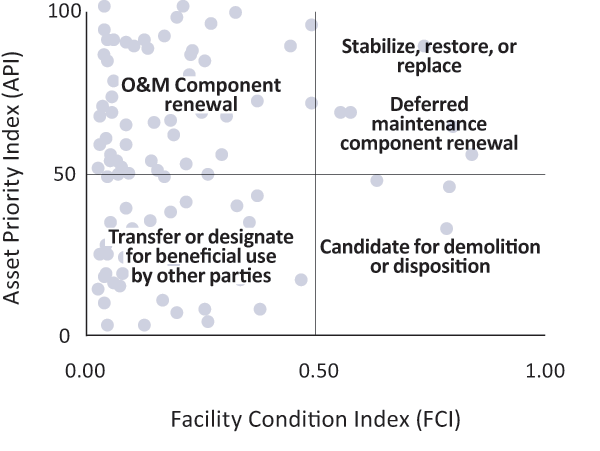Prioritization System Helps National Park Service Manage Assets, Maintenance and Operations
These three evaluation criteria (FCI, API, and critical systems) were applicable to decisions involving every aspect of asset management, including operations and maintenance decisions. Preventive maintenance tasks were being assigned to critical equipment and systems in the NPS inventory, but rather than applying the funding to all assets, systems, and equipment, a more strategic approach was employed: applying the most resources to the highest priority assets in the best condition to gain an optimal return on investment. This prioritization system helps the National Park Service manage assets, maintenance and operations. (See "Establishing Priorities for Investment" below.)
NPS incorporated this approach into how NPS facility managers strategically plan and execute work. Harvey reviewed past spending trends across NPS and recognized that the mindset of NPS facility managers was to try to fix or maintain all assets. From a strategic perspective, this mindset was neither resulting in an effective use of available funding nor possible to achieve. Only when the combination of FCI, API, and critical systems criteria was adopted did things change. This approach has transformed NPS facility managers' evaluation process into one where strategic decisions are supported by data and information rather than being made as a reaction to a particular need.
Using API and critical systems along with FCI provides a valuable tool in identifying the assets with real issues that can be solved. Such a tool is particularly important because NPS is facing a backlog of approximately $11 billion and must preserve assets of cultural or historical significance. Although the task to maintain 70,000 assets for perpetuity is still a daunting one, with this tool and the combination of asset management practices, it is achievable.
This method — combining FCI with API and system criticality metrics in decision-making processes — has gained acceptance over time and increased the visibility and validity of the NPS asset management program. The NPS culture has also changed: from reactive to strategic, data-driven management of assets. NPS facility managers now regularly discuss ways to improve the use of data in decision-making. This significant cultural change transcends NPS facilities management. Now, NPS managers outside of facilities departments, as well as managers in other agencies working with NPS, are gaining an appreciation for the program's strategic approach and the powerful combination of metrics used to support everyday decisions.
Douglas W. Kincaid is president of Applied Management Engineering (AME), Inc., of Virginia Beach, Va. The firm was the principal author of the book Managing the Facilities Portfolio, where the FCI metric was first published in 1991, and the ratings that appeared in that book were based on data from evaluating AME clients.
Tim Harvey, chief, and Mary Hudson, asset management project manager, both of the park facility management division of the National Park Service, and Scott L. Prestridge, PE, CCE/A, Booz Allen Hamilton, also contributed to this article.
Establishing Priorities for Investment
The National Park Service looks at multiple metrics to determine where to invest preventive maintenance funding. Assets falling into the top left quadrant should receive the bulk of the preventive maintenance funding.

|
Related Topics:
















